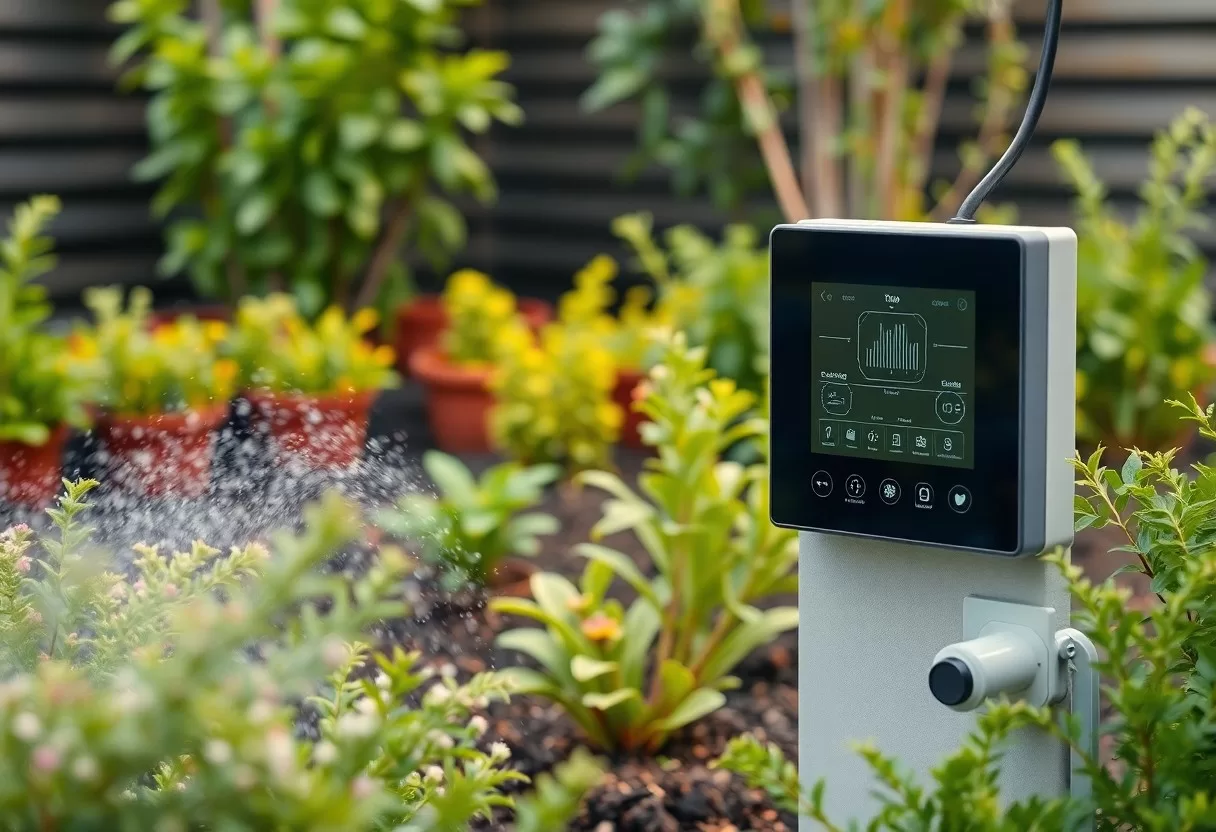Smart Irrigation Systems – The Future Of Water-Efficient Gardening
Just imagine transforming your garden into a thriving oasis while conserving valuable water resources. Smart irrigation systems offer you the opportunity to maximize water efficiency through advanced technology that tailored its watering schedules to meet the unique needs of your plants. By integrating sensors and weather forecasting, these systems prevent both overwatering and underwatering, ensuring your garden not only thrives but also contributes to sustainable practices. In this blog post, you will discover how investing in smart irrigation can lead to a healthier garden and a smaller environmental footprint.

Key Takeaways:
- Smart irrigation systems utilize sensors and weather data to optimize water usage, ensuring that plants receive the right amount of moisture.
- These systems can be controlled remotely via smartphone applications, providing gardeners with flexibility and convenience.
- By reducing water waste, smart irrigation contributes to sustainable gardening practices and helps conserve valuable water resources.
- Integration with IoT technology allows for real-time monitoring and adjustments, adapting to changing environmental conditions.
- Investing in smart irrigation can lead to healthier plants and decreased water bills over time, promoting both economic and environmental benefits.

Rethinking Resource Management: The Crisis of Water Scarcity
Water scarcity is redefining how you manage resources in your garden. As global populations surge and climate change intensifies, the demand for fresh water is becoming increasingly unsustainable. You may be shocked to learn that nearly 2 billion people live in countries experiencing high water stress, forcing you to reconsider traditional gardening practices that may further deplete this vital resource.
The Global Water Crisis: Causes and Consequences
The global water crisis stems from a combination of factors, including urbanization, industrial demand, and agricultural practices. As water sources dwindle, the consequences extend beyond thirst; they impact food systems, health, and ecosystems. This multifaceted issue demands immediate action to ensure that today’s practices don’t jeopardize future water availability.
The Impact of Traditional Gardening on Water Resources
Traditional gardening methods often exacerbate water scarcity, leading to significant waste. Conventional practices can use up to 50% more water than necessary, primarily due to overwatering and inefficient irrigation systems. As you tend your plants, it’s vital to assess whether your approach contributes to this escalating crisis or if your gardening techniques can be optimized for better sustainability.
For instance, the reliance on high-volume sprinkler systems that indiscriminately soak the entire yard results in substantial runoff and evaporation, ultimately wasting precious water. Additionally, traditional gardening often ignores the natural landscape’s ecological balance, which can lead to soil degradation and further reduce water retention capabilities. Adopting more sustainable practices, such as drip irrigation or xeriscaping, can significantly reduce your water footprint and support a healthier environment. By being proactive and informed, you can shift your gardening methods to be more water-efficient, positively impacting both your local ecosystem and the global water crisis.
Revolutionizing the Garden: Features of Smart Irrigation Systems
Smart irrigation systems are transforming traditional gardening practices by incorporating advanced technologies to enhance water efficiency. Features such as real-time monitoring, customizable watering schedules, and compatibility with various smart home devices allow you to manage your garden effortlessly. These high-tech systems adjust to environmental conditions and plant needs, ensuring that your garden thrives while minimizing wasted water. With precise control over every watering cycle, you not only cultivate a healthier landscape but also contribute to sustainable water management.
Key Technologies Behind Smart Irrigation
Your smart irrigation system relies on a suite of innovative technologies, including weather-based controllers, soil moisture sensors, and cloud-based software. Weather-based controllers utilize real-time meteorological data to adjust watering schedules according to rainfall and humidity levels, while soil moisture sensors detect when your plants need watering. Cloud-based software allows for remote management and analysis of your irrigation patterns, enabling you to make adjustments from anywhere, ensuring optimal conditions in your garden.
How Sensors and Automation Optimize Water Usage
Sensors monitoring soil moisture levels continually provide data that guides your irrigation system, ensuring water is applied only when necessary. This technology reduces excess usage and promotes healthier root development, leading to robust plant growth. By automating the process, you can avoid overwatering and under-watering, addressing the natural variability of climate and soil conditions. Consequently, this not only conserves water but can also lower utility costs.
Through adaptive algorithms, these systems learn from historical data, fine-tuning the amount of water supplied based on seasonal patterns and plant requirements. For example, a typical smart irrigation setup might reduce water usage by up to 30%, as it adjusts automatically with changing weather conditions. With real-time updates, you can make informed decisions about your watering practices, potentially leading to healthier plants and overall better garden performance, while also doing your part in combating water scarcity. Investing in such technology represents a long-term commitment to sustainability in gardening.
Environmental and Economic Advantages of Smart Solutions
Smart irrigation systems offer significant environmental and economic benefits by optimizing water usage, minimizing waste, and enhancing the health of your garden. These systems reduce reliance on manual methods and promote efficient water management practices. By employing innovative technology, you can enjoy not only thriving plants but also lower utility bills. Explore more about these innovative solutions to water scarcity – smart irrigation.
Reducing Water Waste and Lowering Bills
Smart systems significantly reduce water waste through precise application, ensuring that water is used only when necessary. By continuously monitoring soil moisture and weather conditions, you can save as much as 50% on water bills compared to traditional irrigation methods. This efficiency not only contributes to the conservation of precious resources but also translates into tangible savings on your monthly expenses.
Benefits for Plant Health and Crop Yields
Enhanced plant health and improved crop yields are direct results of implementing smart irrigation solutions. With precise watering schedules tailored to your garden’s specific needs, plants receive the ideal amount of moisture, which promotes strong root development and overall vigor. Research has shown that optimized irrigation can lead to increases in yields of up to 30% in certain crops. Additionally, improved moisture balance minimizes the risk of diseases associated with overwatering, ensuring healthier plants.
When plants receive water on cue, you enable them to adapt better to the environmental conditions and stress factors, which can elevate their resilience. For instance, smart systems adjust watering based on seasonal changes, preventing stress during droughts while avoiding over-saturation during rain. This balance not only boosts productivity but also contributes to the long-term sustainability of your garden or farm, yielding fruits and vegetables that are healthier and more nutrient-rich.
From Design to Implementation: Building Your Smart System
Creating an effective smart irrigation system starts with careful planning and consideration of your garden’s unique layout and needs. Assess factors such as soil types, sunlight exposure, and available water sources, as these elements dictate your system’s design. Integrating advanced technologies like soil moisture sensors, weather-based controllers, and automatic valves will help you tailor a solution that not only conserves water but also nurtures your plants efficiently.
Choosing the Right Equipment for Your Needs
Selecting the appropriate equipment is vital for the success of your smart irrigation system. Consider components such as smart controllers, which use weather data and soil moisture levels to adjust watering schedules, along with efficient drip irrigation systems that deliver water directly to the roots. Pair these with rain sensors to prevent overwatering during wet periods, ensuring your setup maximizes efficiency and effectiveness.
Practical Steps for Integrating Smart Irrigation in Your Garden
Integrating smart irrigation into your garden can be an effective, step-by-step process. Start by evaluating your current watering practices and identifying areas for improvement. Next, install necessary components like a smart controller and soil moisture sensors. Be sure to map out irrigation zones, adjusting the layout to accommodate the diverse needs of various plants. Regular maintenance checks and updates to your software will keep your system optimized for peak performance.
To start integrating smart irrigation, focus on specific actions such as choosing a smart controller with Wi-Fi capabilities, which enables remote monitoring through an app. Installing soil moisture sensors at different depths ensures you receive accurate readings that dictate when and how much to water. Designing zones based on plant types allows for tailored watering schedules that improve efficiency. Additionally, regularly calibrating your system ensures that it adapts to seasonal changes, enabling you to enjoy a thriving garden while conserving water.
The Future of Gardening: Trends and Innovations on the Horizon
As gardening evolves, embracing technology becomes paramount in addressing issues like water scarcity and climate change. The future of gardening lies in increasingly sophisticated solutions that promise not only to simplify your gardening tasks but also to enhance the overall sustainability of your practices. Innovations in smart systems integrate seamlessly with data analytics, allowing you to make informed decisions on resource usage, leading to a greener, more resilient garden.
Emerging Technologies in Smart Irrigation
New developments in sensor technologies and artificial intelligence are reshaping how you approach irrigation. Soil moisture sensors, coupled with AI algorithms, can predict plant water needs based on real-time weather data. You’re now able to receive precise watering schedules aimed at maximizing efficiency, ultimately saving you water and reducing utility costs while keeping your plants healthy.
The Role of Policy and Community Initiatives in Promoting Adoption
Government incentives and community programs are vital in promoting the adoption of smart irrigation systems. Leaders in your area may offer rebates or tax credits, encouraging individuals to invest in sustainable technologies that benefit the wider community. These initiatives not only support your efforts but also contribute to a collective goal of environmental conservation.
In many regions, local governments are taking active steps to enhance water conservation and promote smart irrigation practices through education and resource availability. For instance, workshops can provide valuable insights into the latest technologies, while local partnerships might facilitate grants for smart gardening products. By fostering these community-driven initiatives, you will find ample opportunities to upgrade your gardening methods while also inspiring your neighbors, creating a culture of sustainability and care for our shared resources. As more communities recognize the value of efficient water use, regulations may increasingly favor smart irrigation systems, solidifying their role as standard practice in modern gardening.
Final Words
Drawing together the insights on smart irrigation systems, you’ll find that embracing this technology is necessary for achieving water-efficient gardening in your own yard. By optimizing water usage and ensuring your plants receive the right amount of moisture, you not only enhance their growth but also contribute to sustainable gardening practices. For a deeper understanding of how these systems work and their benefits, consider exploring Smart Irrigation: Water Conservation and Efficiency. Your garden, the environment, and your water bill will thank you.
